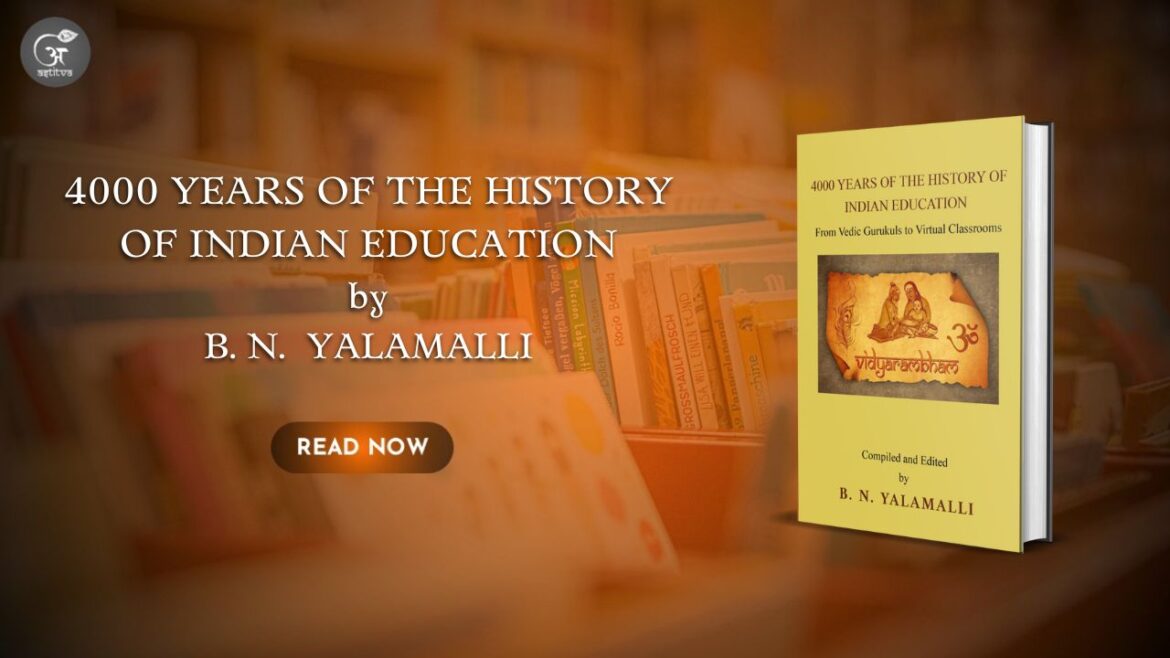In the vast landscape of literature on Indian education, a landmark contribution has emerged with 4000 Years of the History of Indian Education: From Vedic Gurukuls to Virtual Classrooms by B. N. Yalamalli. This meticulously crafted book is not just a chronicle of historical facts—it is an insightful journey through millennia of India’s educational evolution. Drawing from the contributions of countless Indian educationists over more than a century, this work has been skillfully compiled, analyzed, and presented by an author who brings both technical precision and a deep cultural perspective to his subject.
The book is divided into three distinct but interconnected parts. The first part spans an impressive 4000 years of Indian educational heritage, beginning with the Vedic era around 1500 BC. Here, Yalamalli takes readers through the ethos of the ancient Gurukul system, where learning was rooted in values, discipline, and spiritual growth, and then steadily advances through the changing landscapes of Buddhist monastic education, the Islamic Madrasas, the colonial Macaulay-influenced framework, and eventually into the diverse, digitally driven education models of the 21st century. This part not only offers a sweeping historical overview but also presents it with contextual relevance, supported by facts, data, and scholarly insights.
Part two of the book turns its lens to the present. It addresses the current issues and challenges that plague the Indian education system today—ranging from infrastructural gaps and curriculum irrelevance to the digital divide and socio-economic disparities. But unlike many critiques that dwell only on problems, Yalamalli goes a step further by offering thoughtful, pragmatic solutions. His recommendations, drawn from real-life experiences and supported by substantial data, speak directly to educators, policymakers, and administrators who are in a position to effect meaningful reform.
The third and final part of the book explores future possibilities. With perspectives curated from modern educationists and visionaries, this section explores the trajectory that Indian education could and should take. The author discusses the potential of artificial intelligence, personalized learning, hybrid models of education, and the need for value-based education in the digital era. By combining predictions with grounded realities, he ensures this part is both visionary and actionable.
What sets 4000 Years of the History of Indian Education apart is not just its academic depth, but its accessibility. Yalamalli, being a retired mechanical engineer with over four decades of experience in the global watch industry, brings a methodical, systems-based approach to the book. His writing is clear, data-backed, and insightful. Even though he comes from a technical background, his interest in social history and education is evident in the passion and discipline with which this book has been assembled.
This book is a resource goldmine—spread across 368 pages filled with comprehensive data, reflective essays, and well-structured narratives. It is especially useful for a wide audience including education policymakers, school and college administrators, teachers, students, parents, and members of the education industry. For aspirants of competitive exams like the IAS and UPSC, the book serves as both a reference guide and a contextual study tool, offering clarity on historical perspectives and contemporary issues in Indian education.
Equally significant is how this book serves as a bridge between the past and the future. Yalamalli’s work does not merely recount India’s educational journey; it offers a way forward. He has treated the education system not just as a passive subject of study, but as a dynamic entity shaped by cultural, economic, and political forces. His holistic perspective and inclusive writing style ensure that readers, irrespective of their background, can find both information and inspiration within its pages.
At the age of 80, B. N. Yalamalli’s transition from a mechanical engineer to an author of historical and educational texts is itself a story of intellectual evolution. Having been trained in wristwatch manufacturing in Japan and contributing to the global watch industry for over 42 years, Yalamalli now applies the same precision, patience, and purpose to his writing. His commitment to lifelong learning and civic engagement is deeply reflected in the integrity of this book.
In conclusion, 4000 Years of the History of Indian Education is more than a historical document—it is a living archive and a call to action. It encourages readers to reflect on the strengths of our ancient systems, to evaluate the missteps of the past, and to engage critically with the opportunities of the present and future. B. N. Yalamalli has gifted India a legacy text that will remain relevant for educators, scholars, and inquisitive minds for years to come.
